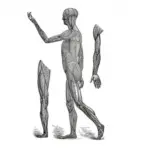
The human being is a complex animal. Underlying his reality as a living organism is both the ability to feel deep emotions and the ability to develop cognitive hypotheses about the way reality is presented to him.
For many years, emotion and cognition were understood as independent and even competing realities forming an artificial antagonism in which affections were relegated to the background of the animalistic and the irrational.
However, today we know that emotion and cognition are two necessary gears for the optimal functioning of the mind, so the impairment of any of them will compromise important processes throughout life.
In this article we will review the somatic marker hypothesis (HMS) proposed by the prestigious neurologist Antonio Damasio; which articulates an integrated explanatory model to understand the way we feel, decide and act.
Emotions, cognition and physiology
Emotions have, in addition to a purely affective component, cognitive and physiological correlates. We can all imagine at this very moment how we felt the last time we experienced fear, one of the basic emotions. Our heart rate quickens, we breathe profusely, our muscles tense, and our entire body prepares for a rapid fight-or-flight response. Sometimes, this response is so immediate that it obviates any previous process of cognitive elaboration.
Just as we are able to evoke these physical sensations, we may be able to glimpse the thoughts that are usually associated with them. We are instantly able to interpret that emotional stability has been altered in the presence of an environmental threat, and consequently we become aware that we are experiencing fear. Both phenomena, physiological reactions and cognitive certainty, seem to happen in a coordinated and automatic way.
However, from the very beginning of the study of emotions, which unfortunately took a long time as a consequence of having been understood as irrelevant epiphenomena, theorists questioned the order in which both moments of the process occur: Are we afraid? Why are we trembling or do we tremble because we are afraid? Although our intuition could make us think the latter, not all authors have followed this line.
William James, who focused his efforts extraordinarily on the dynamics that govern emotional life, postulated that the emotion we perceive at a given moment is the result of the interpretation of physiological signals, and not the other way around. Thus, When we feel that our body begins to sweat or become active, we would conclude that we are overcome by the emotion of fear ; assembling sensations and emotions into an integrated experience.
From such a perspective, which Damasio recovers to give shape to his somatic marker hypothesis, the body would have the ability to anticipate the very consciousness of what we are feeling at every moment, asserting itself as a sentinel to guide consciousness in multiple areas of life. In a way, it could be said that the physiological imprint of the experience ends up “programming” the body to issue quick responses to situations that require it.
What is the somatic marker hypothesis?
The human being resides at the perennial crossroads of two great worlds: the exterior (which he perceives through the sense organs) and the interior (which takes the form of thoughts and images through which he represents and elaborates his individual reality). . Both are coordinated, so that The situations that we must live through are colored by the thoughts that are developed around them and from which a specific emotional response emerges.
The occurrence of positive and negative situations is inherent to the very fact of living, and all involve an emotional response that involves both physiology and cognition (sensations and interpretations). The result of each of our experiences brings together the specific event, the thoughts that arise, the emotion that emerges and the physiological response that erupts; all of this being stored entirely in the increasingly thick registers of episodic memory.
This complex sequence involves a succession of phenomena that, under normal conditions, occur unconsciously and automatically. Both thoughts, the emotion that depends on them, and physiology itself, take place without us deliberately trying to channel them in any direction. For this same reason, many people directly link the event experienced with emotions and behavior, ignoring the mediating contribution of their way of thinking.
Well, each emotion involves the activation of different brain regions, as well as bodily sensations that are specific to it due to its evolutionary properties. Joy, fear, sadness, anger, disgust and surprise imply in each case a different and identifiable physiological reaction. When through our experience we face real situations that precipitate them, an association is produced between the events experienced and the way they made us feel.
This effect follows the basic laws of learning, associating the general characteristics of the situation with the contingent emotion that accompanies it, all of this being extended to subsequent events that harbor similarities with respect to the original. In this way, primary inducers (environmental stimuli that caused the emotion in the first place) and secondary inducers (subsequent environmental stimuli to which the original event-emotion relationship generalizes) are distinguished.
In the initial moments of the process of evaluating a present experience, while the cognitive mechanisms required to respond to the environment with maximum immediacy and success are deployed within us, In parallel, the somatic and visceral reaction that was experienced in response to an event similar to the one we faced in the past emerges in parallel. The question is: how does this double and overlapping reaction, based on previous experience, but with a proactive capacity, affect us?
What is your function?
It is said that humans are the only animal that trips over the same stone twice. That is, when faced with a situation very similar to the one in which he made a mistake, he tends to repeat the same strategy only to end up immersed again in the turbulence of failure. And popular wisdom, embodied in the rich Spanish proverb, also suggests that: “the first time was your fault, but the second time was my fault.” The wisdom of our ancestors should never be underestimated.
The truth is We have very limited cognitive resources. Every time we face a new situation of high demand we usually go through a period of anxiety that even compromises our state of mind; because we need all the mental capacity available to extract, codify, systematize and understand the information that is involved; processing it efficiently to offer an appropriate response to the extent possible.
This process is known, in general terms, as decision making. If we understand it in the way indicated in the previous paragraph, it is tempting to interpret that emotions have not contributed at any point in the process, but the truth is that the evidence indicates that they are absolutely necessary to select the best course of action in the context of a multiplicity of possible paths to choose from.
Emotion acts as a guide, definitely. It tends to unfold before each significant event in our life, forming part of its memory when it is remembered even many years later. For all of this to be possible, the brain requires numerous structures, reserving the amygdala (located deep within it) for emotional memory.
Well, when we face a demanding situation similar to the one we may have experienced at another time in the past, the body sets in motion a somatic marker: we immediately feel the bodily sensations that occurred on the previous occasion (those specific to fear, anger, , sadness, etc.), offering us these a compass on the appropriate decision at the current moment equating what was experienced in the past with what is being experienced now.
At a colloquial level, this phenomenon has been transmitted through popular expressions such as “I had a hunch,” which make a direct allusion to the physiological components (heart rate) that occurred at the moment of making a decision, and that at the same time dessert decanted the process. In this way, emotion would be acting as a mechanism of cognitive economy through its somatic components, and releasing the high load of cognitive processing.
Conclusions
Emotions and cognition are inextricably linked in all basic decision-making processes so these require the integrity of the brain structures on which they depend.
The somatic marker would resort to the physiological pattern of emotions that took place during past experiences to facilitate a prospective analysis of current ones, contributing to choosing specific paths of action in complex environments.
The convergence of emotion and cognition is called feeling (which acquires greater experiential depth), which requires the orbitofrontal cortex and the amygdala in interaction, as well as the integrity of the connections that unite them. This is why frontal injuries (tumors, accidents, etc.) have been consistently associated with difficulties integrating emotion into decisions, which leads to difficulties in assuming one’s own personal autonomy.








